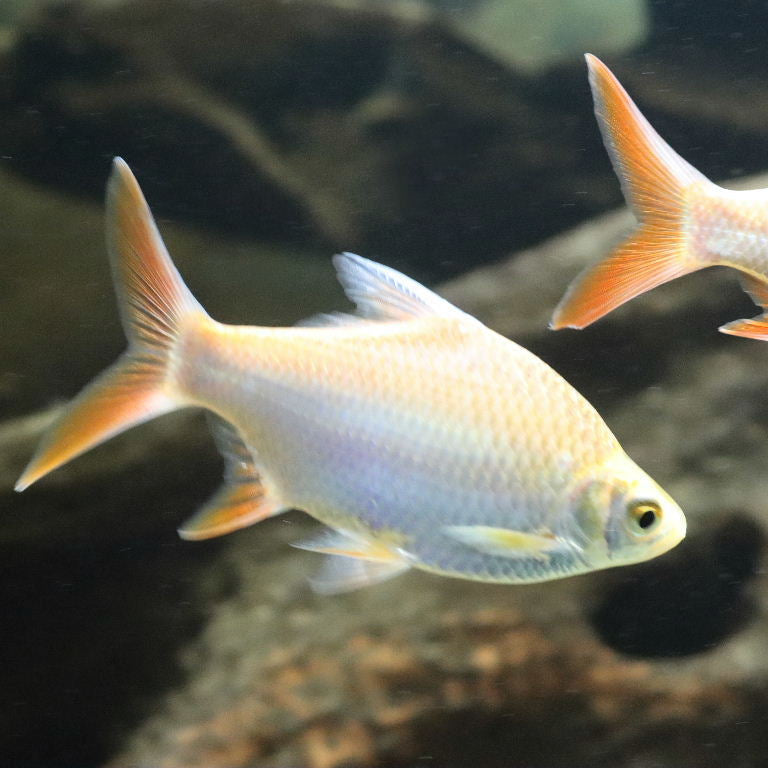You will not be allowed to compare more than 4 products at a time
View compareVendor
Angel Exotix AquariumALBINO TINFOIL BARB
ALBINO TINFOIL BARB
SKU
Product Type
Out of stock
Estimated delivery: 2-3 Days from order date.
Free Shipping & Returns: On orders above €70
- Free Delivery & Free Shipping
- Secure Online Payment
Couldn't load pickup availability
More payment Option

Description
Additional Information
Fish Care
Reviews
Description
The graceful and ever-so-spectacular fish such as Albino Tinfoil barb prefer large aquaria and share their bond with other tropical fish similar in size and temperament.
The Albino Tinfoil Barb (Barbonymus schwanenfeldii variant) is a large, fast-swimming freshwater fish known for its shimmering silver-white body, bright red fins, and striking albino coloration. This schooling species is a selectively bred variant of the Tinfoil Barb, a fish native to the large rivers and floodplains of Southeast Asia, including Thailand, Malaysia, and Indonesia
Tinfoil barbs are smart and intelligent pets that can easily recognize their owners. You can even hand-feed them and teach them exciting things like swimming through the hoops.
Tinfoil barbs have great instincts. They can hear vibrations in the water and even detect pressure changes and other movements.
In some countries, tinfoil barbs are considered a delicacy and bred on fish farms.
In terms of swimming and tank activities, tinfoil barbs are considered superactive freshwater fish that are capable of swimming up to 37 miles per hour.
Most tinfoil barbs are artificially colored and sold under many names including pink, orange, and blue tinfoil barbs, etc.
Additional Information
The tinfoil barb requires a very large tank, at least 75 gallons (284 liters) for one and a much larger aquarium when keeping these barbs in multiples because of their potential adult size of 13 inches (32 cm).
They like to have lots of space for swimming and they are indeed fast swimmers. They also like to jump out of tanks that don't have tight fitting hoods.
The sides of the Tin foil Barb resemble tin foil (hence the name) and the fins on the this barb will become more red as they mature. Juveniles (pictured below) lack the red on the fins. The second picture is of a mature tinfoil barb that is around 10 inches in size.
Diet :
Tin foil Barbs will accept most fish food, including flakes, pellets, frozen and freeze-dried foods. They will also go after your live plants and any smaller fish if given the opportunity.
In the wild, Tinfoil Barb have an omnivorous diet, meaning they consume both plant matter and small aquatic animals. Their diet is diverse and can vary depending on the specific habitat and food availability. They feed on a variety of aquatic plants and algae. They may graze on submerged and floating vegetation, including aquatic mosses, algae mats, and the tender parts of aquatic plants. The species also consume various small invertebrates found in the water, including insect larvae, crustaceans (such as tiny shrimps and small freshwater crayfish), and zooplankton.
They are opportunistic feeders and may consume organic detritus and decaying plant material. This helps recycle nutrients in their ecosystem. Tinfoil Barb may prey on small fish fry or fish eggs, particularly during their breeding season when they are actively foraging for food. They will also readily consume aquatic insects, terrestrial insects that fall into the water And flying insects that are near the water's surface. Their diet can vary throughout the year, depending on the seasonal availability of food sources. During the wet season when their habitats may flood, they may have access to a wider variety of food items due to the expansion of their environment. In contrast, during the dry season, food sources may be more limited.
Tinfoil Barb Breeding Timeline
Tinfoil Barb breeding behavior is influenced by seasonal changes in their natural habitat, particularly when water levels rise, and conditions become favorable for spawning. The rainy season typically leads to an increase in water levels, the flooding of floodplains and areas adjacent to rivers and streams. This flooding creates new habitats, including shallow, slow-moving waters with submerged vegetation. Known to engage in group spawning, which means that multiple individuals of both sexes participate in the breeding process. During this time, males and females gather in suitable spawning areas. The male Tinfoil Barb may prepare potential spawning sites by clearing debris, leaves, and detritus from submerged vegetation or submerged structures like roots and branches. These cleaned areas serve as suitable locations for egg deposition.
The female releases their eggs into the prepared spawning sites, and the male fertilizes them externally by releasing sperm. The adhesive eggs stick to the substrate, such as plant leaves or submerged objects. In some cases, the adults may guard the eggs and provide some protection against potential predators. However, this level of care can vary among individuals and populations. After a certain incubation period, the fertilized eggs hatch into free- swimming larvae. These larvae are very tiny and vulnerable at this stage and may drift with the water currents. The survival rate of the fry (young fish) in the wild can be relatively low due to predation and other environmental factors. Those that survive will grow and develop over time.
Gender
Gender determination of Tinfoil Barb can be challenging, especially when they are young, as there are no prominent external sexual dimorphism characteristics (physical differences between males and females). However, as they mature and approach breeding age, subtle differences may become noticeable. In some cases, females may be slightly larger and have a fuller body shape compared to males. Males may appear slimmer, especially when they are not actively in breeding condition.
Fish Care
Scientific Name : Barbonymus schwanenfeldii
Common Names : Goldfoil Barb, Schwanefeld’s Barb, River Barb
Family : Cyprinid
Origin Tropical regions in Borneo, Sumatra, Thailand, and the Malayan peninsula
Diet : Omnivore
Care Level : Moderate
Activity : High
Lifespan : 8 to 10 years
Temperament : Semi aggressive fish
Tank Level : All levelsMinimum Tank Size75 gallon minimum (125+ – 200+ recommended for a school)
Temperature Range : 72.0 to 77.0° F (22.2 to 25.0° C)
Water Hardness 2 – 10 dGH
pH Range : 6.5 – 7.5
Filtration/Water Flow : Strong
Water Type : Freshwater
Breeding : Egg Scatterers
Difficulty to Breed : Difficult
CompatibilityCompatible with like-minded and like-sized fish species
OK, for Planted Tanks? : With Caution
FAQ's
Reviews
You may also like
ALBINO GOLD AROWANA
ALBINO BANJARED AROWANA
ULTRA BLUE BASE GOLDEN AROWANA - PREMIUM
SUPER RED AROWANA
24K GOLDEN AROWANA
BLUE BASE GOLDEN AROWANA
- Choosing a selection results in a full page refresh.









